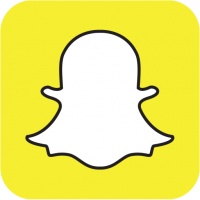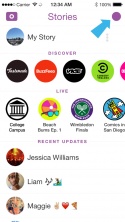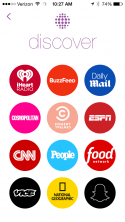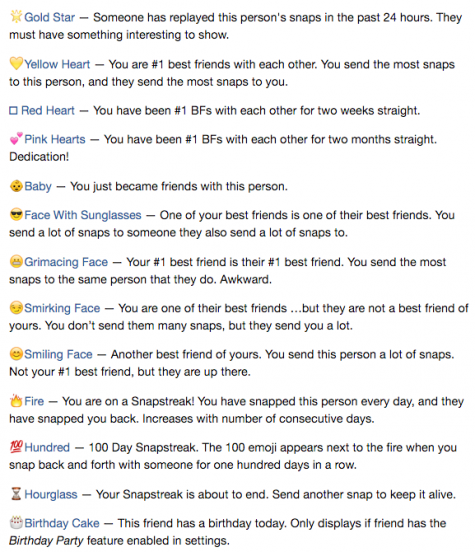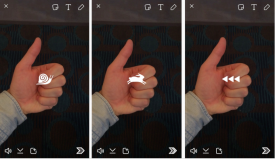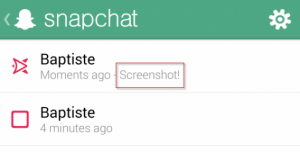Snapchat
|
Snapchat is a social media app that allows users to send photos and videos to their friends. Different effects, captions and drawings can be added to these 'Snaps.' Users choose how long they want their snap to last for. Snaps can last for up to 10 seconds and then disappear forever, unless the receiver of the snap took a screenshot of the snap. In 2013, Snapchat added a new feature that allows users to replay one snap per day. Snapchat has become the 3rd most popular social networking platform among millennials. As of April 2016, It is currently ranked number 4 on the 'Top Charts' for app downloads in the Apple iTunes Store.
History
Reggie Brown and Evan Spiegel are the co-creators of Snapchat. They met freshman year at Stanford University when they joined the same fraternity. In Kappa Sig, Spiegel and Brown met fellow co-founder and future programmer of the app, Bobby Murphy. Brown and Spiegel had a knack for entrepreneurship and launched an app called Picaboo in July of 2011. Brown sparked the idea for the app when he said, "I wish these photos I am sending this girl would disappear." Picaboo was later renamed to Snapchat. At first, the app slowly grew in popular, but eventually exploded in popularity among high schoolers.
In April 2012, Lightspeed Venture Partners invested $485,000 into Snapchat. This was the first big investment that Snapchat received. By Winter of 2012 the app was released to Android phones. Snapchat also introduced the video-sending feature. By February of that year, over 60 million snaps were being sent per day.
By May of 2013, 150 million snaps were being sent per day. With Snapchat's growing popularity and success, Mark Zuckerberg offered to buy Snapchat for $3 billion in November of 2013, but Snapchat declined.
Despite the app's growing success, there was an ongoing lawsuit between the original founders over who truly came up with the idea for the app. After years of battling it out in court, it wasn't until 2014 that the lawsuit was finally settled between the founders. Spiegel and Murphy paid Reggie Brown an undisclosed amount to end the tumultuous lawsuit.
By May of 2015, Snapchat was valued at approximately $16 billion.
Features
When Snapchat was initially launched, users were only able to send pictures to each other. Snapchat has introduced a variety of new features as it continues to update and improve.
Snapchat Videos
In December of 2012 Snapchat introduced the video feature. Users can take and send short videos via Snapchat to their friends. Snap videos cannot be re-watched and expire after they are watched. A snap video can last up to 30 seconds.
Snapchat Story
In October of 2013 Snapchat introduced the story feature. Previously the only people that could see your snaps were other users that you individually sent snaps to. The story feature allows users to post a snap of a photo or video that everyone on their list of Snapchat friends can see. It is automatically deleted after 24 hours, but unlike individual snaps it can be watched many times. There is also a way to see who watched your snap story or took a screenshot of it.
In June of 2014 the 'Our Story' feature was released. Users could now post their snaps to a single-event based story that all Snapchat users could see. The 'Our Story' featured different cities, sporting events, fashion shows, holidays, major world events and more. Snapchat was no longer just a way to communicate with friends but also offered a way to stay updated with different cultural and world events through people's personal selfies, pictures and videos.
Discover
In January of 2015 Snapchat introduced the Discover feature. It allows Snapchat users to see content from different brands or networks like MTV, CNN, People and National Geographic that is updated daily. They post short content videos with the option to read the full story.
Instant Messaging and Video Calling
In May of 2015, Snapchat introduced an instant messaging and video calling feature. Users can respond to a snap by messaging back the sender or send a short video. Users can also video call each other if they are both on the app at the same time. This can be done by clicking click the box button in the left bottom corner to access your snaps, then swiping right on a particular person's name. This is where the user can choose from the different modes of messaging.
Trophy Case
In Snapchat's major update in September 2015, they debuted the Trophy Case. This case unlocks trophies for reaching a certain milestone on Snapchat from hitting a certain number of points to sending your first video snap [1]. Users can access their trophy case by hitting the white ghost in the top center of the landing page and hitting the trophy symbol that is in the same spot. There the trophies appear. If the user has earned a trophy, the emoji is displayed. If the user has not hit the milestone, a lock emoji is seen, followed by a question mark if clicked. This makes it difficult for users to attain the trophies as there is no way to know how to earn them. Snapchat stated that there is no public list of the trophies, but users can learn as they go. But, there is speculation of what is needed to acquire certain trophies, one such list can be found here.
Friends List Emojis
In September 2015 Snapchat introduced the friends list emojis. These emojis show up next to a friend's name over time for several different reasons. They are private and only can be seen by the user. These reasons, along with their corresponding emoji, are listed to the right.
Other emojis appear on Snapchat as well. These custom emojis are in a person's name and represent an official, verified account. [2]
Filters and Effects
Original Filters and Effects
In December of 2013, Snapchat introduced timestamps, temperature, speed overlays and color filters. These can be used after taking a picture on Snapchat and swiping through to view the different options. Snapchat also lets user draw on their pictures using their finger. The user can pick any color they wish and add to their already taken pictures.
Lenses
In September of 2015 Snapchat introduced different lenses for selfies. These features came after Snapchat acquired the Ukrainian startup Looksery in September 2015, which specializes in adding live animated effects to videos [3]. This was the power behind Snapchat lenses, which let you choose a face filter to animate your selfies [4]. Some lenses are obvious right away, while others require the user to open their mouth. In order to use the lenses, a user must be using the front camera in selfie mode. They then must press and hold their face on the screen until the lenses appear along the bottom. The user can then slide through the different lenses and choose to use one as they wish. Snapchat provides up to ten options to choose from. Originally, Snapchat offered users the ability to purchase their favorite lenses for $0.99, but they recently scrapped that idea. Instead, they now update the lenses on a daily basis, replacing the oldest lens with a new one everyday [5]. But if users previously bought lenses, they will be permanently available.
Speed Modifiers
In October 2016 Snapchat introduced a new set of filters called "Speed Modifiers" for videos [6]. These filters include slow motion, fast forward, or rewind effects. To use these filters, a user must first shoot a video on Snapchat and then swipe until the filters appear.
Geofilters
Geofilters were eventually introduced. They are visual overlays that can only be used at certain locations. For example major cities and famous locations have geofilters for users to use. Anyone can make and submit an image for a geofilter to Snapchat for approval. Companies can also sponsor geofilters to promote their brand or product. This has become a source of major revenue for Snapchat.
These filters, effects and geofilters make Snapchat more fun and enjoyable for users.
Usage at Michigan
Snapchat is widely popular among University of Michigan students, and the University was one of the first institutions to create an official Snapchat account. The following was gathered from a survey about Michigan students' Snapchatting habits:
- 43% use Snapchat to flirt
- 86% send Snapchats to friends at Michigan
- 90% send Snapchats to friends at other schools
- 77% mostly send "selfies" on Snapchat
- 16% mostly send Snapchats that are not of themselves
- 67% make ugly faces in Snapchats
- 18% avoid making unattractive faces in snapchats
- 46% only send Snapchats to their close friends
- 20% use the Snapchat Stories feature
- 59% send Snapchats when they go out at night
- 83% send Snapchats during the school day
- 61% send Snapchats during class
[1]
Ethical Concerns
Do The Pictures Truly Disappear?
What separates Snapchat from other photo and video messaging apps is that the content sent to Snapchat friends disappears after it is opened. This 'vanishing' feature sends mixed messages to users. Many users think this means they can send explicit content without worrying about other people seeing. But, the golden rule of the internet is that whatever is put on the internet is there forever and virtually anyone can figure out a way to see it. Even if you press 'delete,' it is very difficult, if not impossible, to permanently delete files from cyberspace. Snapchat even warns in their privacy policy, "A few final words on deletion: We can’t guarantee that messages and corresponding metadata will be deleted within a specific timeframe." In fact in 2011, a user figured out a way to get these 'deleted snaps' back. Founder Evan Spiegel responded to this hack saying, "The people who most enjoy using Snapchat are those who embrace the spirit and intent of the service. There will always be ways to reverse engineer technology products — but that spoils the fun!" While this may be true, there is a definite misconception among users that content permanently vanishes.
Ban of Third Party Apps
As Snapchat became more popular, so to did third party apps that allowed one to save snaps sent without notifying the sender of the photos. Apps like SnapSave, SnapSpy, SaveSnap, and SnapGrab were brought to light after the third party app Snapsaved was hacked and more than 90,000 photos or videos were posted online.[2] Since then, Snapchat has banned all third party apps. Snapchat now states that using third-party applications to access Snapchat can not only compromise your account, but is now a "violation of our Terms of Use." The app developer says: If you are using third-party applications to access Snapchat, please change your password and stop using these applications. If you continue to use these apps, we will have to lock your account. If you have already been locked, you may be able to unlock your account by changing your password. If you do not stop using third-party applications, your account may be permanently locked.[3]
Screenshots and Privacy
The only way to save a snap is to take a screenshot of it, but the original sender of that snap is notified. This feature was put in place to discourage users from taking screenshots. Unfortunately many technology blogs have revealed ways to take screenshots without the other person knowing. Another way people save snaps without even taking a screenshot is by using a second device to record and save the content. That picture or video is often sent around without the original sender even knowing. While this is a complete violation of privacy, users use Snapchat at their own risks and as Snapchat reminds users in its privacy policy, "The same common sense that applies to the Internet at large applies to Snapchat as well: Don’t send messages that you wouldn’t want someone to save or share."
What information does Snapchat save and use? They have your location, access to photos, and activity in other apps collected by cookies. Snapchat is less interested in the content of their photos but more into the metadata it provides. Snapchat records the filters you use, the stories on 'Discover' you view, if you have replayed a snap, and more. They do this to improve their services. They also use metadata from outside apps you use in order to cater the content you see to your interests. Snapchat's privacy policy is worth a read if you want to know exactly all of the data they use and how they use it. You give up this privacy when using the app.
Sexting
Sexting through Snapchat has become widely popular. A major concern is that minors may be involve in these sexting activities. To join Snapchat a user has to be 13 and older. In a 2013 UK study, 47% of Snapchat users aged 18-30 had received nude photos and 67% of users had received images that had "inappropriate poses or gestures."
In 2014 at the University of Washington, there was a user study conducted that surveyed 127 adult Snapchat users. It consisted of about 40 online questions that took between 15-30 minutes to complete. Only 1.6% of the participants said they use Snapchat primarily for sexting while 14.2% did admit to sending explicit content via Snapchat at some point. This survey shows that a majority of users are using Snapchat to send strictly funny content to their friends. When asked why users chose Snapchat over other sites and apps to send this type of content, many said it was because of the vanishing feature.
References
1. What marketers should know about Snapchat, Nicola Kemp, 13 June 2013 http://www.brandrepublic.com/article/1186152/marketers-know-snapchat
2. Here's one big reason Snapchat is worth $16 billion, Eugene Kim, 29 May 2015 http://www.businessinsider.com/snapchat-huge-among-millennials-2015-5
3. Snapchat's 'disappearing' videos don't actually vanish, Laurie Segall, 28 December 2012 http://money.cnn.com/2012/12/28/technology/security/snapchat-security-flaw/
4. Sex, Lies, or Kittens? Investigating the Use of Snapchat’s Self-Destructing Messages, Franziska Roesner, Brian T. Gill, and Tadayoshi Kohno, 2014 http://homes.cs.washington.edu/~yoshi/papers/snapchat-FC2014.pdf
5. Snapchat is Now the Third Most Popular Social Network Among Millennials, http://mwpartners.com/snapchat-is-now-the-third-most-popular-social-network-among-millennials/
6. Snapchat Geofilters, https://www.snapchat.com/geofilters
7. Snapchat Privacy Policy, https://www.snapchat.com/privacy
8. A Brief History of Snapchat, Jordan Crook and Anna Escher, 15 October 2015 http://techcrunch.com/gallery/a-brief-history-of-snapchat/
9. Snapchat Launches Discover, Jordan Crook, 27 January 2015 http://techcrunch.com/2015/01/27/snapchat-launches-discover/
- ↑ "Hail to the Snappers?" http://www.hercampus.com/school/u-mich/hail-snappers
- ↑ CNN http://money.cnn.com/2015/04/03/technology/snapchat-apology/
- ↑ Quote from Snapchat's Terms of Servicehttp://www.zdnet.com/article/snapchat-issues-outright-ban-on-third-party-apps-following-4chan-hack/
